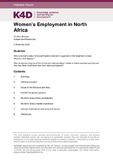Women’s Employment in North Africa
Abstract
Despite increased educational parity between the genders and declining fertility rates, female labour force participation rates in Algeria, Egypt, Morocco, and Tunisia remain low and even declining. This phenomenon is a shared attribute among Middle East and North Africa (MENA) countries and has therefore been dubbed by the literature as ‘the MENA gender paradox’. The literature covers this topic either through a deep dive in one country or a group of countries to understand demographic patterns of participating women and their experiences in the labour market, or through a regional perspective, pointing to shared structural, institutional, or cultural qualities that result in the low female labour force participation. The first branch of literature makes apparent that part of the low participation can be attributed to an accounting issue; women are overrepresented in subsistence work, which is hard to capture and goes uncounted in most surveys. Beyond that, education and occupation matter; educated women constitute a minority in the population but a majority among participating women. Within the second branch of literature, some look to cultural or Islamic values to explain the low female labour force participation. This is met with mixed results as well as criticism regarding weak conceptualization and reductionism. Instead, other studies delve deeply into the various economic, structural, and institutional factors and the interactions between them that caused the sustainability of these cultural norms and, consequently, the stagnation in female labour force participation. These include factors like dual labour markets that push women into unemployment and inactivity, social policies that reinforce a traditional family structure, and the resource curse from oil revenues that inhibited the growth of female-dominated fields (the traded sector) and maintained a high level of wages that allowed the one breadwinner family to remain affordable.
Citation
Boustati, Alma. (2020) Women’s Employment in North Africa. K4D Helpdesk Report. Brighton, UK: Institute of Development Studies.Is part of series
K4D Helpdesk Report;916Rights holder
© Crown copyright 2020Sponsor
FCDO (Foreign, Commonwealth and Development Office)Collections
- K4D [937]

